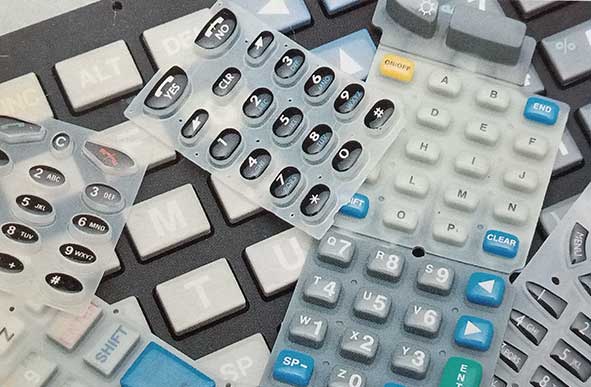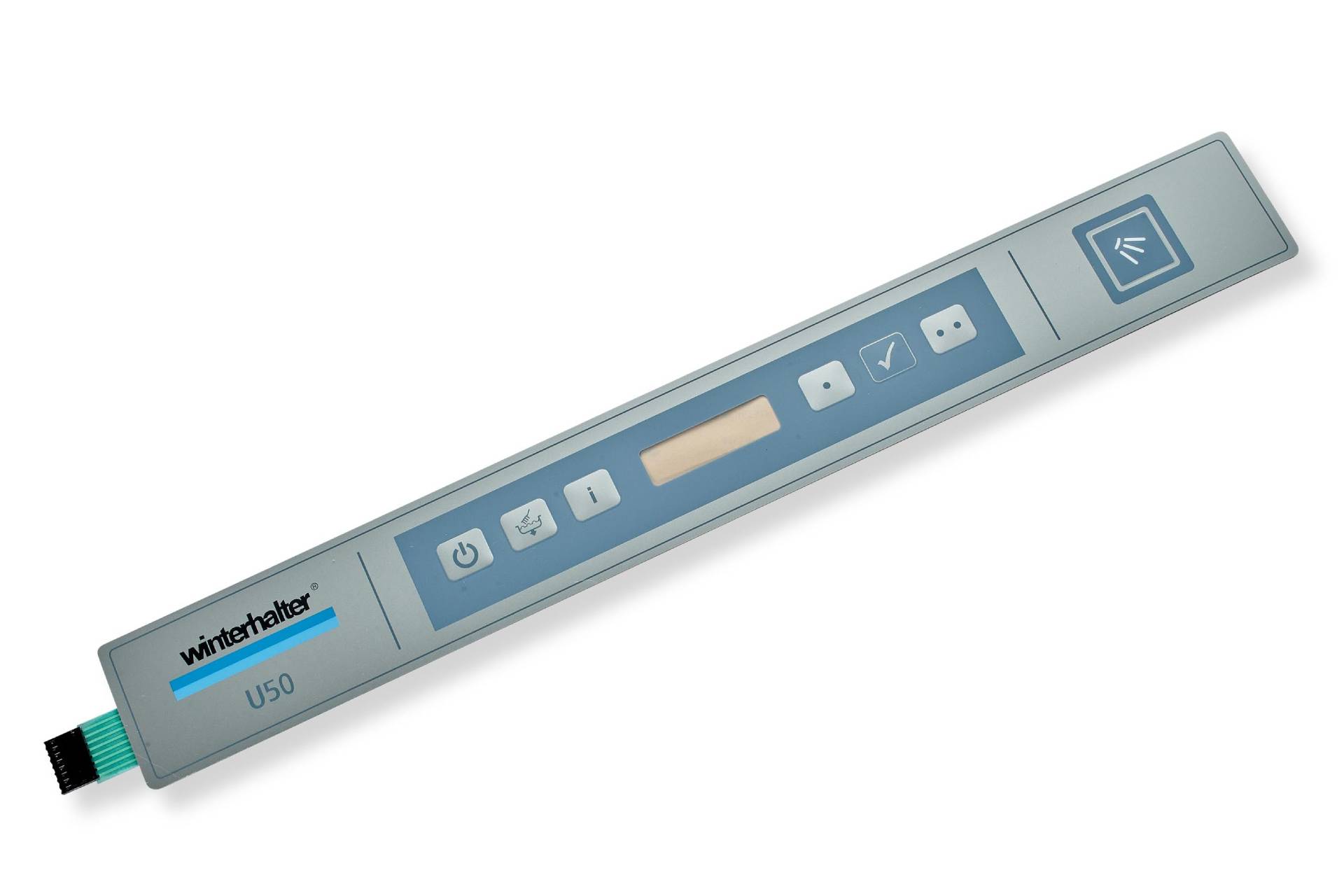Comparing Rubber Keypads to mechanical switches: What You Should Know
Uncovering the Diverse Keys In and makes use of of Rubber Keypads in the Modern Technology Landscape Today
Rubber keypads have actually established themselves as crucial parts in different technical applications. Their versatility makes them appropriate for customer electronics, commercial equipments, and clinical gadgets. As these keypads continue to progress, brand-new customization alternatives and style patterns emerge. This motivates a better evaluation of their advantages and producing procedures. Understanding these components might reveal why rubber keypads stay a recommended option in the modern technology landscape. What lies ahead for this flexible element?
Summary of Rubber Keypads
Rubber keypads act as a fundamental element in different electronic gadgets, offering a responsive interface for individual communication. These keypads are usually made from silicone or rubber materials, which give adaptability and durability. Their design frequently incorporates raised letters or icons, boosting use by enabling users to feel the tricks - Rubber Keypads. Rubber keypads are resistant to dirt, wetness, and use, making them suitable for demanding settings
Furthermore, they can be personalized pertaining to form, color, and dimension, permitting producers to create special user interfaces customized to certain items. The production process often entails strategies such as molding and printing, making certain top notch outcome. Consequently, rubber keypads not only boost performance but likewise add to the general aesthetics of the device. With these features, rubber keypads stay a preferred selection for both producers and consumers, stressing their relevance in the technology landscape.
Typical Applications in Consumer Electronic Devices
While many electronic gadgets depend on touchscreens for individual communication, rubber keypads remain to play a vital function in customer electronics. These keypads are widely used in tools such as remote controls, gaming controllers, and household home appliances, where responsive feedback enhances customer experience. Their longevity and resistance to wear make them ideal for tools often subjected to hefty use.
Rubber keypads are additionally preferred in mobile devices and mobile phones, where small designs demand responsive and dependable input approaches. The ability to customize the form and structure of rubber keypads permits makers to produce distinct styles that appeal to consumers. In addition, the soft touch of rubber provides comfort during extended use, making these keypads a favored selection for tools needing prolonged interaction. Overall, rubber keypads continue to be a crucial component in the consumer electronic devices landscape, incorporating capability with easy to use attributes.
Role in Industrial and Medical Devices
Rubber keypads play a vital role in both industrial and medical devices, supplying resilience and reliability in demanding settings. In industrial settings, they are commonly used in control panels and equipment, improving operator communication with facility systems. In the clinical area, rubber keypads assist in easy to use user interfaces for tools that need accuracy and health.
Industrial Devices Applications
Keypads play an important duty in the functionality and user experience of industrial and clinical equipment. In commercial settings, rubber keypads offer a durable interface for equipment and control systems, enabling operators to conveniently input commands and change settings. Their resistance to dust, wetness, and chemicals guarantees dependability under extreme conditions normal of factories and manufacturing plants. In addition, the tactile comments provided by rubber keypads improves user communication, minimizing the likelihood of input mistakes. In enhancement to conventional machinery, these keypads are indispensable in automated robotics and systems, where accuracy is critical. The convenience of rubber keypads in different commercial applications underscores their significance in improving functional performance and guaranteeing safety in complicated settings.
Medical Tool Assimilation
As clinical devices progressively call for user-friendly interfaces, the integration of rubber keypads has ended up being important in ensuring effective interaction in between medical care professionals and devices. These keypads offer responsive comments, helping with user-friendly procedure also in high-pressure atmospheres. Their durability and resistance to extreme cleaner make them perfect for clinical setups, where hygiene and long life are crucial. In addition, rubber keypads can be customized to consist of various shapes, dimensions, and colors, boosting aesthetic acknowledgment and accessibility for customers. This versatility permits the development of specialized controls customized to particular clinical functions, improving total effectiveness. As a result, the role of rubber keypads in clinical tool assimilation not just boosts functionality however also advertises individual security and functional integrity in health care atmospheres.
Personalization Options and Layout Trends

Current design trends highlight minimalism and ergonomics, prioritizing individual convenience and instinctive interaction. Personalized logo designs and branding can be incorporated into keypads, enabling firms to maintain a cohesive brand identification throughout their items. Additionally, developments in producing methods, such as silicone molding, have actually made it easier to attain elaborate layouts and individualized formats.
Benefits of Rubber Keypads Over Other Types

Rubber keypads are also understood for their resilience and resistance to environmental variables. They can stand up to temperature, dirt, and moisture variations, making them excellent for outdoor or commercial settings. Furthermore, rubber keypads are commonly quieter than their plastic or metal equivalents, minimizing environmental pollution in common settings.
The cost-effectiveness of rubber keypads makes them an appealing choice for producers. Their lightweight nature adds to reduce delivery expenses, while their adjustable designs deal with certain branding requirements. Generally, rubber keypads stand for a reliable and versatile service in the modern technology landscape.
Manufacturing Techniques for Top Quality and Sturdiness
In the production of rubber keypads, the Check Out Your URL selection of suitable materials and molding procedures plays an essential role in determining total quality and longevity. Different molding techniques, such as compression and shot molding, significantly affect the end product's efficiency. Comprehending these aspects is necessary for achieving excellent results in rubber keypad production.
Molding Procedures Explained
A range of molding procedures play an essential function in the manufacturing of rubber keypads, ensuring both quality and toughness. One of the most usual techniques include compression molding, transfer molding, and shot molding. Compression molding includes putting rubber in a warmed mold and mildew, where heat and pressure form it into the wanted type. Transfer molding enables more specific control over product circulation and is suitable for intricate styles (Rubber Keypads). Shot molding, understood for its rate and efficiency, infuses molten rubber into a mold and mildew under high pressure, generating high-volume get rid of regular high quality. Each method uses distinct benefits, influencing aspects such as production speed, expense, and design adaptability, eventually impacting the efficiency and life-span of rubber keypads in numerous applications
Material Option Significance
Material choice plays a review crucial duty in the production of rubber keypads, directly influencing their performance and sturdiness. The choice of rubber substances, such as silicone or polyurethane, influences tactile comments, resistance to put on, and ecological resilience. Top notch products ensure that keypads can withstand comprehensive usage, keeping their functionality over time. In addition, the solution of rubber impacts its resistance to temperature variations and direct exposure to chemicals, which are vital for gadgets in numerous atmospheres. Employing sophisticated manufacturing methods, such as compression or shot molding, more improves the structural honesty of keypads. Eventually, mindful material option and production processes contribute greatly to the general high quality, durability, and customer satisfaction of rubber keypads in today's technology landscape.
Future Trends in Rubber Keypad Modern Technology
As modern technology remains to develop, the future of rubber keypad technology shows up promising, with improvements poised to improve performance and individual experience. One significant fad is the assimilation of touch-sensitive technology, enabling capacitive responses that mimics the feeling of standard buttons while offering enhanced responsiveness. Furthermore, the advancement of antimicrobial materials is likely to obtain grip, dealing with hygiene worries in common and public devices.
Modification alternatives are anticipated to increase, enabling customers to personalize vital formats and tactile responses, thus catering to varied requirements. The incorporation of wise technology, such as connection functions, might also arise, allowing rubber keypads to engage with various other tools seamlessly. As producers concentrate on sustainability, environmentally friendly materials are prepared for to end up being a lot more common, lining up with worldwide ecological goals. Generally, these fads promise to revolutionize rubber keypads, making them extra versatile, easy to use, and ecologically aware in the technology landscape.
Frequently Asked Concerns
How Do Rubber Keypads Contrast in Expense to Other Keypad Kinds?
Rubber keypads generally provide an affordable solution contrasted to various other keypad kinds, such as membrane layer or mechanical options. Their reduced manufacturing expenditures and durability make them an eye-catching choice for various applications in modern technology.
What Are the Ecological Impacts of Rubber Keypad Production?


The environmental influences of rubber keypad manufacturing include source depletion, power consumption, and air pollution from making procedures. In addition, incorrect disposal can cause plastic waste, adding to ecological destruction and hurting ecosystems if not taken care of responsibly.
Can Rubber Keypads Be Used Outdoors?
Rubber keypads can be used outdoors due to their resilience and resistance to weather components. Their durability may depend on the top quality of materials made use of and the details environmental problems they are subjected to.
What Upkeep Is Needed for Rubber Keypads?
Rubber keypads need regular cleansing to eliminate dust and debris, regular evaluation for damage, and security from severe temperature levels. Guaranteeing appropriate storage problems can extend their lifespan and maintain functionality over time.
How Do Rubber Keypads Perform in Extreme Temperatures?
Rubber keypads usually keep performance in severe temperature levels, exhibiting resilience to both cold and heat. However, prolonged exposure might cause product deterioration, influencing their responsive response and total performance in rough environments.
Rubber keypads offer as a basic part in various electronic devices, offering a tactile user interface for individual interaction. While lots of digital tools depend on touchscreens for user interaction, rubber keypads continue to play a vital duty in customer electronics. Additionally, the soft touch of rubber gives comfort during prolonged use, making these keypads a recommended option for gadgets calling for prolonged communication. Regardless of the expanding variety of keypad products readily available, rubber keypads use distinct advantages that make them a favored selection in lots of applications. Rubber keypads generally offer an economical option contrasted to other keypad types, such as membrane layer or mechanical choices.